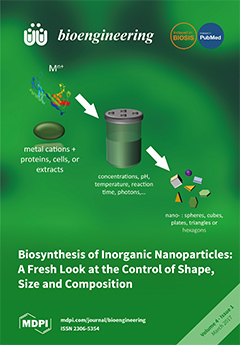Fluorescence resonance energy transfer substrates of sortase A are too expensive to be used to roughly screen high-throughput sortase A inhibitors. This makes therapeutic strategies difficult to realize in a clinical therapeutic use. Instead, we design here an LPETG-EGFP (leucine, proline, glutamic, threonine
[...] Read more.
Fluorescence resonance energy transfer substrates of sortase A are too expensive to be used to roughly screen high-throughput sortase A inhibitors. This makes therapeutic strategies difficult to realize in a clinical therapeutic use. Instead, we design here an LPETG-EGFP (leucine, proline, glutamic, threonine and glycine-enhanced green fluorescence) protein displayed on a yeast surface as a substrate by adaptively reducing the cost. We do this by optimizing the induction conditions of sortase A expression in
Escherichia coli DE3(BL21) and catalyzing LPETG proteins, which are displayed on surface of
Pichia pastoris. Different expression conditions of sortase A include: induction temperature (22 °C, 28 °C, 37 °C and 40 °C), induction time (4 h, 5 h, 6 h and 7 h) and induction concentration of isopropyl β-
d-thiogalactoside IPTG (0.25 mmol/L, 0.5 mmol/L, 1 mmol/L, and 2 mmol/L). The fluorescence change of the LPETG-EGFP protein on the surface of
P. pastoris over time was detected by flow cytometry and fluorescence spectrophotometry, and then the sensitivities of the two methods were compared. Using berberine chloride as an inhibitor, the activity of sortase A was investigated with the substrates of LPETG-EGFP protein, and compared to Dabcyl-QALPETGEE-Edans. A high yield of sortase A was achieved by inducing 1.0 mmol/L IPTG at 28 °C for 6 h. The intensity of green fluorescence of substrates displayed on the yeast surface was increased over time, while the stability was decreased slightly. Both fluorescence spectrophotometery and flow cytometry were fit for detection because of their high sensitivity. We utilized two different substrates of sortase A to investigate sortase A activity, which resulted in the increase of fluorescence intensity with respect to the increased time of growth. However, the method with Dabcyl-QALPETGEE-Edans as its substrate was more robust. Thus, the method described in this paper is a simple and cheap method which is very suitable for high-throughput analysis, but the conventional method is much more sensitive. The method described in this paper is expected to lead to large-scale screening of sortase A inhibitors which can be used to decrease the risk of drug resistance development.
Full article






